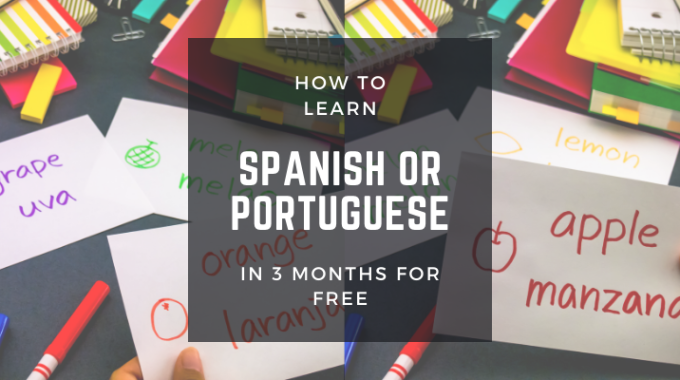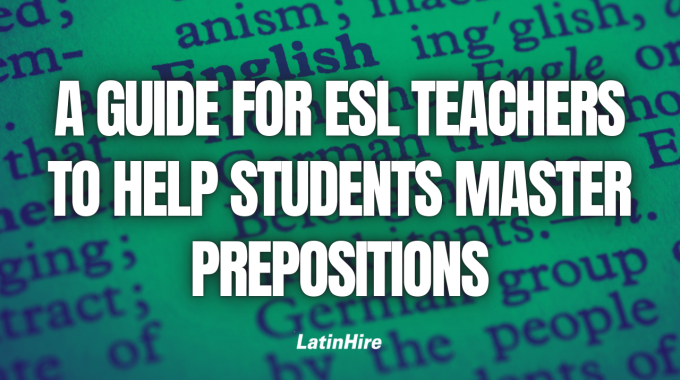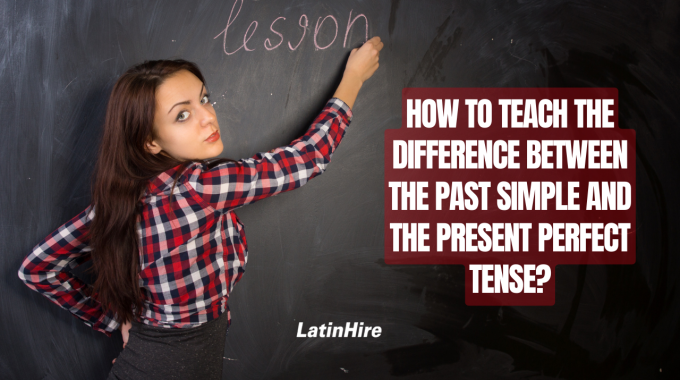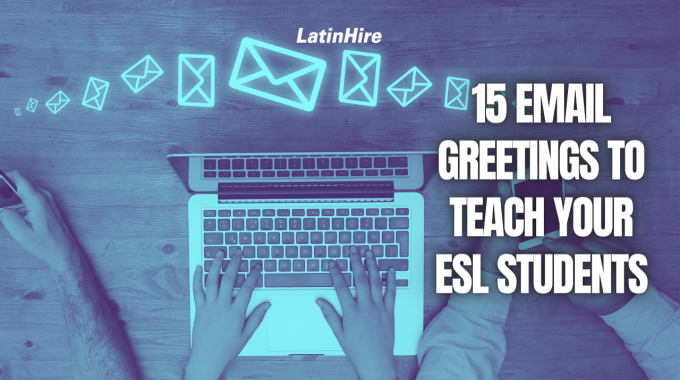Prepositions are some of the most commonly used words in the English language, but also…

How to Learn Spanish or Portuguese in 3 Months for FREE
Learning Spanish or Portuguese should NOT be a daunting experience. Rather, it should be exciting as it opens up doors to new job opportunities, travels, and friendships across Latin America and Europe.
How quickly you learn Spanish or Portuguese will depend on how many consistent hours you put into practicing the language. If you can dedicate 2-3 hours a day of deep study with the right methodology, you can achieve a CEFR A2 conversational level of fluency in only 3 months.
The right methodology is key because no matter how many hours you spend practicing something if you do it the wrong way, you will not get the right results. Too many traditional language schools only focus on grammar, reading, and writing, so students cannot speak the language even after years of learning.
This is why you want to make sure to balance your studying time with all four elements of language. You also want to be producing as much output as you receive input. (Refer to the diagram below.)

Here are 7 steps you can follow to learn Spanish or Portuguese. Although these steps make up the general order you could start in, you’ll soon realize that they can and should be all done simultaneously. Remember, if you can dedicate 2-3 hours a day of studying and practicing, you should be able to reach A2 level fluency in 3 months.
So let’s get started!
Step 1) Learn common VOCABULARY + PRONUNCIATION.
80% of conversation in any language comprises only around 1000 words. That means if you can learn 10-12 new words each day for three months, you’ll have enough vocabulary to carry on a decent conversation. (You can find these lists with a quick Google Search.)
Use Ankidroid or other flashcard apps to help you with remembering new vocabulary. Ankidroid is designed to test you in frequencies that are optimal for memorization.
It’s also very important to learn correct pronunciation early on, so listen to the pronunciation of each word from an online dictionary (e.g. Wordreference or Google Translate) and repeat after it. There are also various Youtube videos that teach the top 1000 words in Spanish or Portuguese, so feel free to use those as well.
Step 2) Learn basic GRAMMAR + common PHRASES.
Get a Spanish or Portuguese grammar book and phrase book to learn basic grammar and common phrases of the language. The Practice Makes Perfect series is a great one and you can find these books online. If it’s a workbook, make sure there is an answer key at the end so you can correct your own work. You can also pay for a subscription language learning service online to get a more interactive experience.
The Lonely Planet also sells phrasebooks for Spanish and Portuguese. You can pick up a PDF copy for a low price on their website and go through a few pages each day. It’s highly recommended to keep a notebook just for recording common phrases, so you can easily refer to it and continuously add to it as you’re learning more phrases.
Step 3) LISTEN to language learning podcasts.
If you are just starting to learn Spanish, the Coffee Break Spanish podcast is a must. In this podcast, the instructor teaches a student Spanish from scratch and every episode covers new vocabulary, grammar, and phrases in context.
Once you get more familiar with Spanish, TED en Espanol and News in Slow Spanish are great podcasts to help you practice your listening.
Coffee Break Languages also has a podcast called One Minute Portuguese where you’ll be able to learn the basics of Portuguese and you can also try other beginner podcasts like Todo Mundo Pod or Practice Portuguese. Once your Portuguese is at an intermediate level, you can try some higher-level podcasts like Histórias de Ninar para Garotas Rebeldes, Café Brasil, or Academia CBN – Mario Sergio Cortella.
Castbox is a fantastic podcast app where you can find all of these podcasts.
Step 4) READ children’s stories + WATCH shows/movies.
Children’s stories and shows are filled with common vocabulary and phrases. Beelingua is a wonderful application with bilingual children’s stories where you can set half of the page to Spanish or Portuguese and the other half in English (or another language). This app also allows you to listen to a native speaker read the story sentence by sentence and you can repeat after them. Get into the habit of reading out loud to help with your language retention.
Children’s shows are a great way to practice your listening comprehension. They tend to have slower dialogues, so you’re more likely to catch the words and phrases that you already know.
You can also rewatch movies and TV series that you’ve already seen in English, but this time in Spanish or Portuguese. Google extensions like Nflxmultisubs and Language Reactor can turn your Netflix and Youtube binges into language learning sessions as they provide options to turn on multiple language subtitles at the same time and also contain multiple other functions to assist your language learning.
Step 5) WRITE a daily journal.
Writing a daily journal in Spanish or Portuguese is a great way to train your mind to think in the new language. At the end of each day, spend 10 minutes writing about what you did that day, what you learned, what you’re thinking, and try to simplify it in a way that you can express your ideas with vocabulary and phrases you already know.
When you discover that you cannot find the words in Spanish or Portuguese to express what you want to say, then it’s the perfect opportunity to look it up and learn something new. (Don’t forget to record it in your phrase notebook.)
Step 6) Practice SPEAKING with others.
You must practice speaking a new language as soon as you can. This is usually the biggest barrier in language learning, so the sooner you get over the fear of speaking, the faster you can increase your language fluency.
Try to find native speakers online or nearby to practice with. You can offer them a language exchange to help them practice a language you know.
Step 7) Create an immersive environment with materials that interest you.
Language immersion is one of the most effective ways to learn a language. If you don’t live in a country that speaks your target language, you can create your own immersive environment by replacing whatever you already do in your native language with the target language.
Make sure to choose material that already interests you. If you like to read about a certain topic, now try to read about that topic in Spanish or Portuguese. If you like to watch certain Netflix series, now set the language to Spanish or Portuguese. If you like to listen to a specific genre of music, now listen to that genre in Spanish or Portuguese.
Use your target language as a medium to learn about things that you’re already interested in. Personal interest is what’s going to keep you committed to language learning in the long run. So analyze your surroundings and see which of your daily activities can be replaced by Spanish or Portuguese.
LatinHire is currently only hiring English teachers who have a CEFR A2 level of Spanish OR Portuguese. If you know one of these languages and are interested in joining LatinHire’s teaching team, click here to apply.
If you don’t already know one of these languages, but would like to join our team, use the steps in this article to launch your language learning journey, and perhaps you can join us in a few months!



